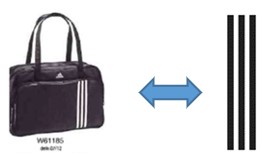Trade mark for simple figurative signs – adidas
The case: adidas marks almost all its goods with signs consisting of three stripes. The design of these signs varies. In December 2014, the following sign was registered by adidas as an EU trade mark for clothing, footwear and headwear.
![]()
However, the same year, a competitor challenged the trade mark due to lack of registrability. They were proved right. The three-stripe mark was cancelled. Why?
Originally, adidas had applied for the mark as a pattern mark, whereby the three stripes are repeated regularly on the surface of a product. However, such protection as a pattern mark failed due to formal errors in the application. Further details of the mistakes made in this case are discussed in the article:
Failed extension of protection by model trade mark – adidas
Nor could the sign be protected as a figurative mark either, as this only protects the individual image.
For a trade mark to be protected, buyers must be able to recognise the mark as a means of distinguishing the goods that bear it from the goods of other companies. However, when the three stripes appear on products, buyers initially see them only as decoration. However, it was possible that the three stripes had acquired a new meaning as a means of distinction in addition to their quality as decoration, a so-called secondary meaning.
adidas invoked this argument and stated that it had used its three-stripe mark extensively. As a result, they said, the public had learned to regard the three stripes as a means of distinguishing adidas’ products. To prove this, adidas submitted 12,000 pages of evidence with representations of the three stripes. However, these pages did not demonstrate the use of the three-stripe mark that was being applied for, only the use of adidas’ other three-stripe representations.
How did these other three-stripe signs differ from the contested mark?
adidas’ contested three-stripe mark had been registered as a black-and-white mark and thus was colourless. Therefore, it consisted of three defined black stripes on a white background, as well as other coloured reproductions with the same contrasts and in the comparable shades that the public associates with the sign.
In order to be able to use the contested mark, its representation, by its very nature, had to have the same characteristics as the marks already used. This was not the case with any of the representations submitted by adidas.
Thus, the white stripes on a dark background below did not contain the specific contrast of the black-and-white stripes, which, in fact, consisted of dark stripes on a light background:

The use of the three-stripe sign on sports bags

did not amount to use of the contested mark for the same reason. But in addition, the three-stripe mark could not be used thus because the latter was registered for clothing, footwear and headwear, and not for sports bags.
Nor could use be made of the following marks:

In particular, the right-hand sign with the three horizontal stripes did not consist of these stripes alone but in conjunction with the word adidas, thus forming a unit.
The General Court of the European Union upheld the cancellation of the adidas mark because it was devoid of any distinctive character and adidas was unable to prove that it had nevertheless acquired distinctive character.
General Court of the European Union of 19.06.2019, T-307/17.
Learnings: Particularly simple signs usually lack any distinctive character. They must therefore specifically acquire the required distinctiveness through use. To be able to prove this, however, you may only use as evidence such signs as trade marks in identical or quasi-identical form. In the absence of this, even registration as a trade mark does not necessarily protect against later cancellation.